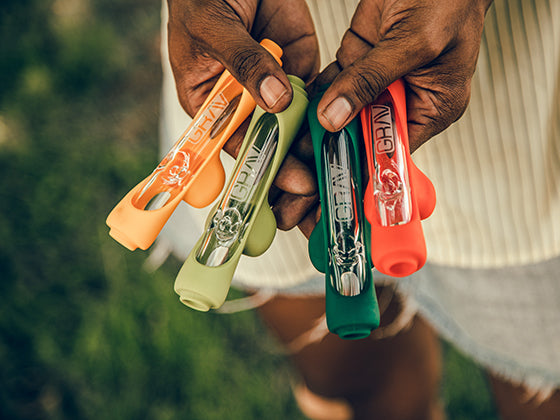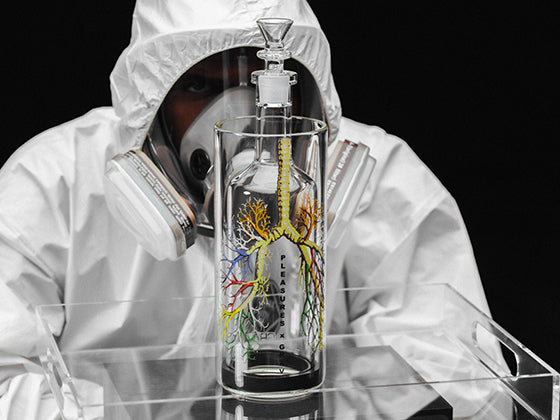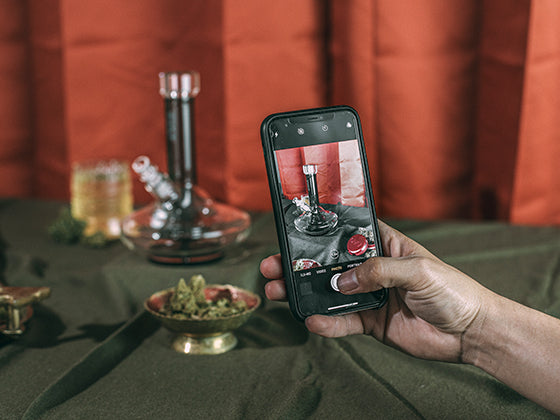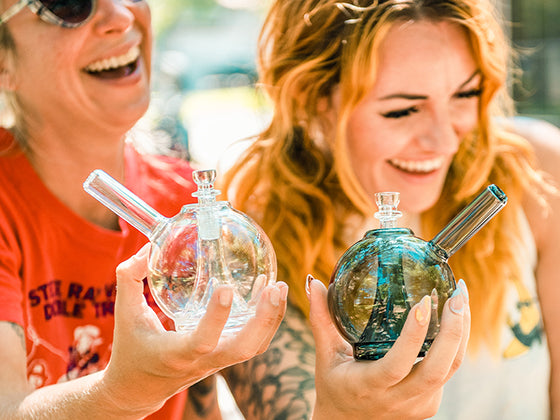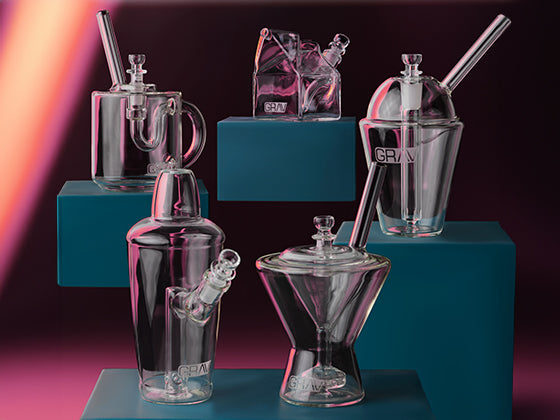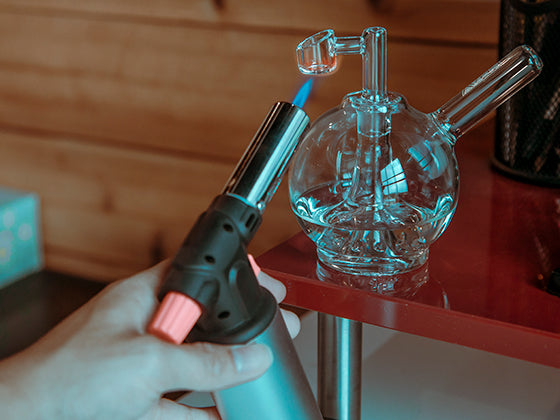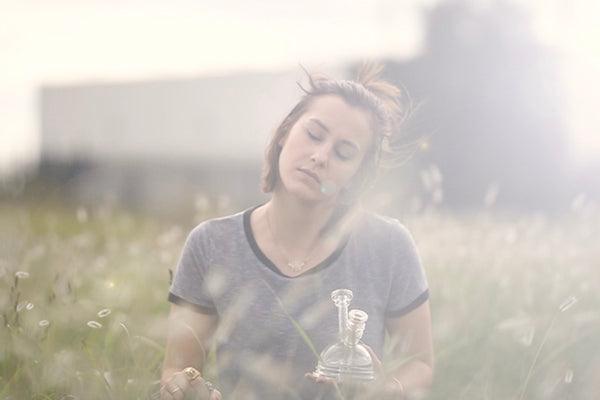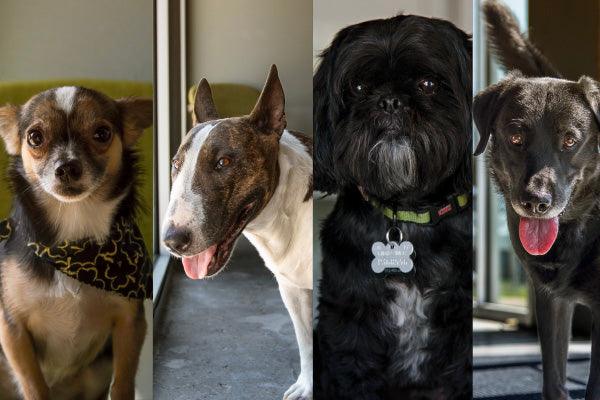A 'crack-off' bucket is where glassblowers throw the hot glass scraps and bits that they’ve 'cracked off' the punty while the piece itself is being formed. The punty is the glass rod a glassblower uses to stabilize a section of tubing while it's being worked on.
Crack-off buckets hold an artist’s mistakes, collect scraps of her genius, and serve as a literal and figurative sounding board for her creative ventures. Whether your crack-off bucket is a dream journal by your bed, or the performances you did alone in front of a mirror before the big speech, or a notepad full of sketches of eyeballs and antlers - the crack-off bucket takes your doodles, takes your garbage, takes the half-formed, half-remembered ideas and allows you the freedom to push on through the creative process.
The most overlooked aspect of any piece of work are the shavings, scraps, splatters, and slices that didn't quite make the cut. We all remark at the beauty of any finished piece of work, but hardly acknowledge, or are even aware of the process that led to its creation. The hard decisions are about what has to be left behind. Every work station, every session, has its own completely distinct mess. Regardless of whether your art is singing, painting, or glassworking, the choice to keep or discard some aspect is consistent across every discipline. And it’s sometimes a difficult choice. Faulkner called it “killing your darlings.”
What do you keep, what do you throw out? What does the mess surrounding a workstation say about the person working there and about the piece being made - about the journey from concept to construct?
During the Armadillo Art Glass Initiative this weekend, I went around to each artist’s workstation to see what I could glean from their messes.

First up is JMass. His workstation is full of personality. You might call it chaotic, but not unorganized or without reason. This reminds me a lot of his work - chaotic, but not without reason. His torch is centered to his body, with additional torch blades and a bench roller directly in front of him, which calls to mind a photographer with multiple lenses poised and ready to swap out. On his right, mostly long skinny tools - tongs, shapers, claw grabbers, and utensils yet to be used. Normally his bucket would be on his right because he's right handed, but at this particular event he’s sharing his crack-off bucket with the artist next to him, Capt’n Cronic, so it’s placed between them.
JMass’ crack-off bucket is especially eye catching, and there’s a story behind it. Apparently, it had belonged to another glassblower who had changed studio spaces, and when the bucket was left behind, JMass took it over. He likes using this bucket because the edges are truly sharper than they need to be, and it's deep enough that you can fill it to the brim without having to change the water or empty the contents. For a novice glassblower, JMass insists that any food service bucket would do.
Next is Micah Evans. His work space is very tidy and minimalist, almost as though there aren't enough tools or pieces to reasonably pull off the magic Micah is managing. Every work station revolves around where the artist’s torch is initially clamped. While JMASS is comfortable standing, allowing him to move around quickly, Micah is seated. Watching him work is like watching someone trying to catch flaming melted noodles with a completely stoic expression. I'd probably prefer to be seated with that kind of work as well. In front of his torch, Micah has all his partially-formed shapes and colors lined up in a row on a little rod-stand. Directly in front of this stand is his crack-off bucket.
Micah's trough-style bucket gives him a lot of surface area to crack a piece on the edge, submerge it in water, or lay the punty across the bucket while he switches tools or hands. To Micah's right are larger shaper tools and tongs, as well as a stand-up display holding more clear tube pieces and a smaller torch for detailed work. On his left, calipers, scissors, clamps, and a circle template - I haven't seen a bonafide circle template in the wild since I was in my college days and I feel a little nostalgic watching Micah measure the circumference of each ring to make sure each one is consistent with the rest.
I go from Micah to N8 Miers - another very minimalist work environment. Nate's work is an amazing combination of glass work and painting to create elaborate space-themed scenes that wrap the whole piece. To the left of his torch is a large circular graphite plate, probably used for shaping & mixing the cattail sized galaxy-colored pieces, and on the right hand side of his station, a stand in front of the torch holds more pieces with melted, partially completed parts, looking frozen in time.
N8 Miers was also using a mason jar as a stand in for his usual crack-off bucket. I really appreciate everyone's special buckets, but there's something amazing about getting to see inside the bucket at all the illuminated waste as it cools and collects at the bottom. I'm not sure what he was building those colors for, but the reddish and blueish scraps looked like the filling for an amazing galactic glass-berry pie.
I visit Raven Copeland's workstation last. I try to take note of all the tools Raven has at his disposal, but I lose track pretty quickly. A wealth of utensils, marble-shapers and other flat wide shaping tools, several tong and claw type tools, as well as a smattering of bright colorful snippets of glass spread out around him. A few square chips of iridescent glass are laid out to the right of his torch, as if next in line to be melted and rolled into a beastly marble. He has two smaller mason jars for crack-off buckets placed in front to the left of the torch, which seemed to not be enough options - or enough space for all the parts involved in the process.
Crack-off buckets hold an artist’s mistakes, collect scraps of her genius, and serve as a literal and figurative sounding board for her creative ventures. Whether your crack-off bucket is a dream journal by your bed, or the performances you did alone in front of a mirror before the big speech, or a notepad full of sketches of eyeballs and antlers - the crack-off bucket takes your doodles, takes your garbage, takes the half-formed, half-remembered ideas and allows you the freedom to push on through the creative process.
The most overlooked aspect of any piece of work are the shavings, scraps, splatters, and slices that didn't quite make the cut. We all remark at the beauty of any finished piece of work, but hardly acknowledge, or are even aware of the process that led to its creation. The hard decisions are about what has to be left behind. Every work station, every session, has its own completely distinct mess. Regardless of whether your art is singing, painting, or glassworking, the choice to keep or discard some aspect is consistent across every discipline. And it’s sometimes a difficult choice. Faulkner called it “killing your darlings.”
What do you keep, what do you throw out? What does the mess surrounding a workstation say about the person working there and about the piece being made - about the journey from concept to construct?
During the Armadillo Art Glass Initiative this weekend, I went around to each artist’s workstation to see what I could glean from their messes.

Crack Off Buckets from AAGI
First up is JMass. His workstation is full of personality. You might call it chaotic, but not unorganized or without reason. This reminds me a lot of his work - chaotic, but not without reason. His torch is centered to his body, with additional torch blades and a bench roller directly in front of him, which calls to mind a photographer with multiple lenses poised and ready to swap out. On his right, mostly long skinny tools - tongs, shapers, claw grabbers, and utensils yet to be used. Normally his bucket would be on his right because he's right handed, but at this particular event he’s sharing his crack-off bucket with the artist next to him, Capt’n Cronic, so it’s placed between them.
JMass’ crack-off bucket is especially eye catching, and there’s a story behind it. Apparently, it had belonged to another glassblower who had changed studio spaces, and when the bucket was left behind, JMass took it over. He likes using this bucket because the edges are truly sharper than they need to be, and it's deep enough that you can fill it to the brim without having to change the water or empty the contents. For a novice glassblower, JMass insists that any food service bucket would do.
Next is Micah Evans. His work space is very tidy and minimalist, almost as though there aren't enough tools or pieces to reasonably pull off the magic Micah is managing. Every work station revolves around where the artist’s torch is initially clamped. While JMASS is comfortable standing, allowing him to move around quickly, Micah is seated. Watching him work is like watching someone trying to catch flaming melted noodles with a completely stoic expression. I'd probably prefer to be seated with that kind of work as well. In front of his torch, Micah has all his partially-formed shapes and colors lined up in a row on a little rod-stand. Directly in front of this stand is his crack-off bucket.
Micah's trough-style bucket gives him a lot of surface area to crack a piece on the edge, submerge it in water, or lay the punty across the bucket while he switches tools or hands. To Micah's right are larger shaper tools and tongs, as well as a stand-up display holding more clear tube pieces and a smaller torch for detailed work. On his left, calipers, scissors, clamps, and a circle template - I haven't seen a bonafide circle template in the wild since I was in my college days and I feel a little nostalgic watching Micah measure the circumference of each ring to make sure each one is consistent with the rest.
I go from Micah to N8 Miers - another very minimalist work environment. Nate's work is an amazing combination of glass work and painting to create elaborate space-themed scenes that wrap the whole piece. To the left of his torch is a large circular graphite plate, probably used for shaping & mixing the cattail sized galaxy-colored pieces, and on the right hand side of his station, a stand in front of the torch holds more pieces with melted, partially completed parts, looking frozen in time.
N8 Miers was also using a mason jar as a stand in for his usual crack-off bucket. I really appreciate everyone's special buckets, but there's something amazing about getting to see inside the bucket at all the illuminated waste as it cools and collects at the bottom. I'm not sure what he was building those colors for, but the reddish and blueish scraps looked like the filling for an amazing galactic glass-berry pie.
I visit Raven Copeland's workstation last. I try to take note of all the tools Raven has at his disposal, but I lose track pretty quickly. A wealth of utensils, marble-shapers and other flat wide shaping tools, several tong and claw type tools, as well as a smattering of bright colorful snippets of glass spread out around him. A few square chips of iridescent glass are laid out to the right of his torch, as if next in line to be melted and rolled into a beastly marble. He has two smaller mason jars for crack-off buckets placed in front to the left of the torch, which seemed to not be enough options - or enough space for all the parts involved in the process.
Getting to eavesdrop on the artists’ processes helped me realize there are even more similarities between creative professionals of all types. Though there were similarities between each station (such as the torch being centered, or the crack-off bucket being on the side of their dominant hand), each individual had their own specific workflow and arrangement (such as having a small torch to pair with the big one, or having specifically marble-shaping tools in abundance). It’s the same across mediums as well, artists may have different tools, different materials, or different types of workstations - but we all participate in the same great creative process, and we each finds way to tailor the ‘means’ by which we acquire our preferred ‘ends’.
This year's Armadillo Art Glass Initiative was an enormous success in no small part because of the great efforts made by these artists, the individuals representing Meals on Wheels, and the people that came out in droves to see the cream of the crop. Click the artists names above to vist their instagrams and see even more examples of their inspiring work.
What’s your creative environment look like - we’re dying to know, leave a comment below!



